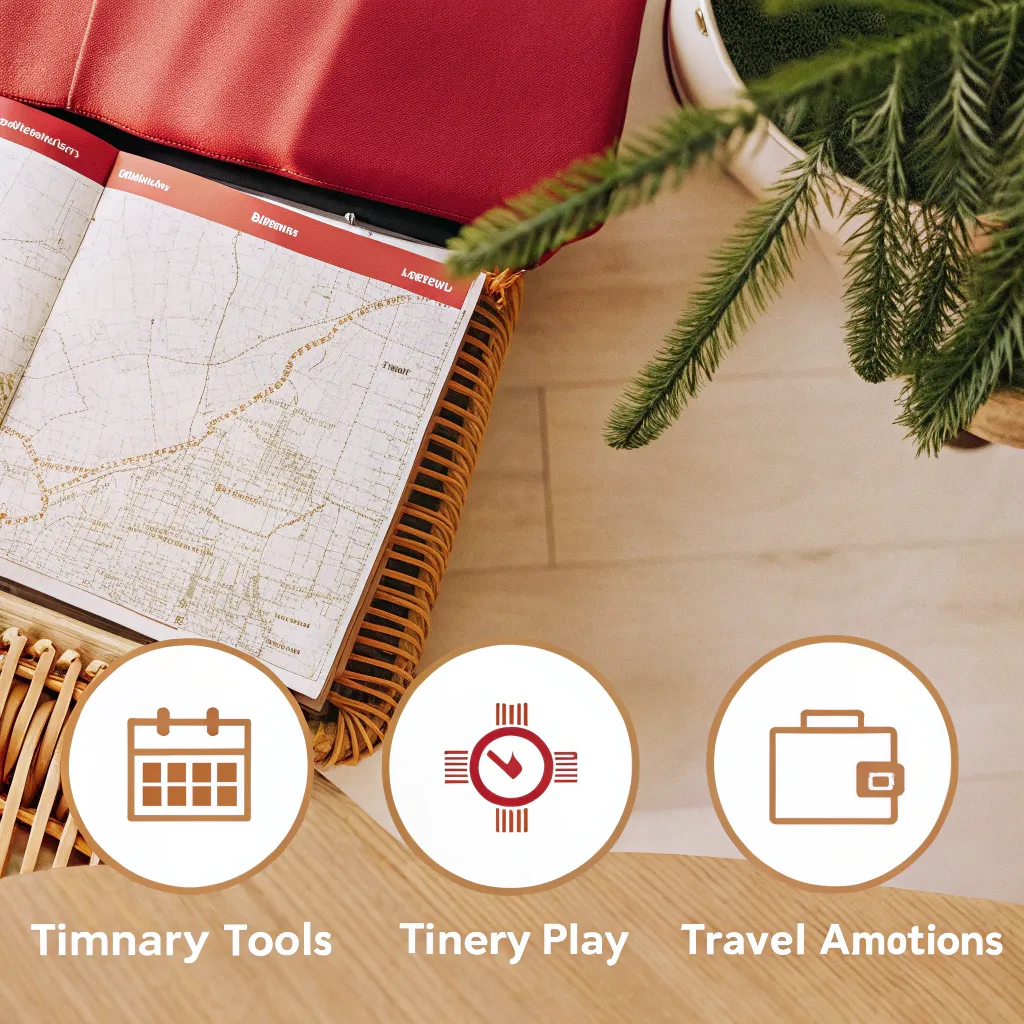Planning a trip can feel like a part-time job. Between comparing flight prices, booking accommodations, organizing activities, and keeping track of confirmation emails, the process can quickly become overwhelming. Fortunately, a variety of digital tools now exist that can handle much of this work for you, transforming travel planning from a chore into an enjoyable part of the journey.
How Modern Travel Planning Tools Are Changing the Game
Remember the days of printed MapQuest directions and accordion folders stuffed with hotel confirmations? Those relics have been replaced by sophisticated apps and websites that not only store your travel documents but actively help organize your entire trip experience.
Today's travel planning tools go far beyond simple storage. Many use AI to suggest itineraries based on your preferences, automatically import booking details from emails, and even provide real-time updates about flight delays or gate changes. They're essentially digital travel assistants that live in your pocket.
"I used to spend weeks planning trips, with spreadsheets and documents everywhere," says Jamie Larson, a frequent business traveler from Chicago. "Now I forward my confirmations to an app and it builds most of my itinerary automatically. It's saved me countless hours."

The Evolution from Manual to Automated Planning
Travel planning has undergone several transformations:
- Paper era: Physical folders, printed confirmations, and handwritten itineraries
- Digital organization era: Spreadsheets, Google Docs, and saved emails
- Current automation era: Specialized apps that organize, suggest, and update in real-time
This evolution hasn't just saved time—it's fundamentally changed how we approach travel planning. Rather than spending hours researching and organizing, travelers can now focus on the experiences they want to have while algorithms handle the logistics.
Top Itinerary Planning Tools Worth Trying
TripIt: The Veteran Email Organizer

TripIt remains one of the most popular travel organizers for good reason. Its core functionality—forwarding confirmation emails to [email protected] to automatically create itineraries—is brilliantly simple yet effective.
The free version handles the basics well, organizing your confirmations into a chronological itinerary. But many travelers find the Pro version ($49/year) worth the investment for features like:
- Real-time flight alerts
- Seat tracking
- Fare refund notifications
- Point tracking
A standout feature is TripIt's ability to work regardless of where you book. Unlike some tools that only integrate with specific booking sites, TripIt can parse emails from virtually any travel provider.
"I've tried at least five different travel apps, but I always come back to TripIt," says Marcus Chen, who travels monthly for work. "It's not the flashiest, but it reliably organizes everything without me having to babysit it."
Wanderlog: For Collaborative Trip Planning
Wanderlog has gained popularity for groups traveling together. Unlike some tools that focus primarily on storing confirmations, Wanderlog excels at the collaborative planning stage.
Key features include:
- Collaborative editing (similar to Google Docs)
- Map-based planning interface
- Restaurant and activity suggestions
- Ability to add notes and links
- Offline access to your itinerary
The visual, map-based interface helps visualize your daily movements, making it easier to plan efficient routes. This can be particularly helpful in cities where you want to group activities by neighborhood.
One Reddit user shared: "Wanderlog was a game-changer for our family trip to Japan. Five of us could add ideas, and we could see everything laid out on a map to avoid backtracking across Tokyo."
Google Travel: The Underrated Powerhouse
Many travelers overlook Google Travel (formerly Google Trips), but it's become increasingly powerful, especially for those already in the Google ecosystem.
Google Travel automatically pulls reservation details from Gmail and organizes them into trips. It also offers:
- Flight price tracking
- Hotel suggestions with price comparisons
- Things to do recommendations based on your interests
- Weather forecasts for your destination
- Saved places from Google Maps integrated into your trip
The integration with Google Maps is particularly useful, allowing you to save attractions, restaurants, and other points of interest directly to your trip itinerary.
"I didn't even realize Google had built such a comprehensive travel tool until recently," notes travel blogger Samantha Wu. "Now I use it alongside more specialized apps because the Gmail integration is so seamless."
Tripsy: For Apple Ecosystem Devotees
Tripsy has carved out a niche as a beautifully designed travel planner specifically for Apple users. With apps for iPhone, iPad, and Mac, it offers tight integration with Apple's ecosystem.
Standout features include:
- Elegant, intuitive interface
- Apple Maps integration
- Ability to add reservations manually or via email forwarding
- Document storage for passports, insurance cards, etc.
- Sharing capabilities with travel companions
While it lacks some of the AI-powered features of competitors, many users appreciate its thoughtful design and privacy-focused approach. The basic version is free, with a Pro subscription ($39.99/year) unlocking additional features.
How to Choose the Right Planning Tool for Your Travel Style
With dozens of options available, selecting the right travel planning tool depends largely on your specific needs and travel habits.
For Business Travelers
If you travel frequently for work, prioritize tools with:
- Automatic email parsing (like TripIt)
- Flight delay notifications
- Expense tracking integration
- Calendar syncing
Business travelers often benefit from paid versions of apps like TripIt Pro or App in the Air, which provide real-time flight updates and alternative flight suggestions when things go wrong.
For Family Vacations
Families planning trips together might prefer:
- Collaborative editing features (like Wanderlog)
- Map-based interfaces to plan efficient routes with kids
- Offline access to information
- Ability to store tickets and reservations for multiple people
"When planning our Disney trip with the grandparents, we needed something everyone could access and contribute to," explains Melissa Torres. "Wanderlog was perfect because my tech-challenged parents could still figure it out."
For Backpackers and Flexible Travelers
Those with less structured itineraries might prefer:
- Tools with good recommendation engines
- Apps that work offline in remote areas
- Flexible planning interfaces that allow for easy changes
- Free options to keep costs down
What About AI Travel Planners?
The newest category of travel planning tools leverages artificial intelligence to create personalized itineraries based on your preferences. Services like Roam Around and Wonderplan are gaining traction.
These AI planners typically ask questions about:
- Your travel dates
- Budget constraints
- Interests and preferences
- Previous travel experiences
- Must-see attractions
They then generate custom itineraries that you can refine and adjust.
While impressive, these tools aren't yet perfect. They sometimes suggest unrealistic timelines or miss nuances that experienced travelers would catch. They're best used as starting points that you can modify rather than definitive plans to follow precisely.
"I tried an AI planner for Paris and was impressed by how it grouped activities by neighborhood," says travel writer James Martinez. "But it suggested I visit the Louvre in just two hours, which is wildly optimistic unless you're sprinting past the Mona Lisa."
How Do People Actually Use These Tools?
According to a recent Reddit thread about travel planning tools, many travelers use a combination of apps rather than relying on just one. A common workflow might look like:
- Use Google Flights and Skyscanner to find and track flight prices
- Book accommodations through various sites
- Forward confirmation emails to TripIt for automatic organization
- Use Wanderlog or Google Travel for collaborative planning of activities
- Download offline maps in Google Maps or Maps.me
- Keep everything accessible on a smartphone during the trip
One Reddit user described their process: "I start with the big booking sites for flights and hotels, then use TripIt to organize everything. For daily planning, I switch to Wanderlog because I like seeing everything on a map. It seems complicated, but each tool does something specific really well."
What Do These Tools Still Get Wrong?
Despite their convenience, today's travel planning tools still have limitations:
- Many struggle with complex multi-city itineraries
- Some have trouble parsing certain email formats
- Few handle ground transportation well (like train connections)
- Most don't account for realistic transit times between activities
- Many lack integration with local transit apps
"I love TripIt, but it sometimes creates separate trips when I have complex itineraries with stops in multiple cities," notes frequent traveler Rebecca Yoon. "I still need to manually adjust things occasionally."
Why Are People Still Using Spreadsheets?
Despite the proliferation of specialized tools, many travelers still swear by good old-fashioned spreadsheets. A Reddit thread from June 2024 revealed that Google Sheets remains extremely popular for travel planning.
Reasons cited include:
- Complete customization freedom
- No learning curve for regular spreadsheet users
- Ability to track budgets alongside itineraries
- No subscription fees
- Reliable offline access when saved properly
One traveler shared their spreadsheet approach: "I have tabs for the overall itinerary, daily plans, packing list, budget tracking, and important information like embassy contacts. No app does everything exactly how I want it, but I can make a spreadsheet do anything."
How to Make the Most of Whichever Tool You Choose
Regardless of which planning tool you select, these practices will help maximize its effectiveness:
- Forward confirmations immediately - Don't let emails pile up; forward them to your planning tool as soon as they arrive
- Set up calendar syncing - Ensure your travel plans appear in your regular calendar
- Download offline versions - Never assume you'll have reliable internet at your destination
- Share access appropriately - Give travel companions the right level of access to plans
- Do a pre-trip review - The day before departure, review your full itinerary to catch any issues
What's the Future of Travel Planning Tools?
The travel planning space continues to evolve rapidly. Trends to watch include:
- Deeper AI integration - More personalized recommendations based on your travel history and preferences
- Augmented reality guides - Pointing your phone at landmarks to get information overlaid on your camera view
- Sustainability features - Tools that calculate and help offset the carbon footprint of your trips
- Local experience integration - Better connections to local guides and authentic experiences
- Improved language tools - Real-time translation integrated directly into travel apps
Industry experts predict consolidation in the space, with larger travel companies likely acquiring successful independent tools to enhance their ecosystems.
Which Travel Planning Tool Should You Use?
There's no one-size-fits-all answer, but based on the most common use cases:
- For simplicity and reliability: TripIt remains hard to beat for organizing confirmations
- For visual, map-based planning: Wanderlog excels at collaborative trip design
- For those deep in the Google ecosystem: Google Travel offers seamless integration
- For Apple users who value design: Tripsy provides a beautiful, intuitive experience
- For complete customization: A well-designed spreadsheet still works wonders
Many travelers find that using a combination—perhaps TripIt for organizing bookings and Wanderlog for planning activities—provides the best of all worlds.
As one seasoned traveler put it in a recent Reddit discussion: "The best tool is whatever reduces your stress and lets you focus on enjoying the trip. For some that's an all-in-one app, for others it's a detailed spreadsheet. The goal is spending less time managing logistics and more time making memories."
FAQ: Common Questions About Travel Planning Tools
Do I really need a specialized travel planning tool?
If you take more than a couple of trips per year or plan complex itineraries, a dedicated travel planning tool can save significant time and reduce stress. For very simple trips with minimal bookings, your email inbox and calendar might be sufficient.
Are free versions adequate, or should I pay for premium features?
Free versions work well for basic organization, but premium features like real-time flight alerts, alternative flight suggestions, and seat tracking can be worth the investment for frequent travelers. Consider how much your time is worth and how disruptive travel hiccups would be to your plans.
What about privacy concerns with these apps?
Different tools have different privacy policies. TripIt and similar services require access to your travel emails, which raises privacy considerations. Google Travel automatically scans your Gmail, which is convenient but involves sharing data with Google. Always review privacy policies before choosing a tool.
Can these tools help with budget tracking?
Some tools like Trail Wallet specialize in travel expense tracking. Most itinerary planners have limited budget features, though some like TripIt Pro offer flight price monitoring to help you book at optimal times.
The travel planning landscape continues to evolve rapidly, with new tools emerging regularly. The best approach is to experiment with a few options to find what works for your specific travel style and needs. After all, the goal of these tools is to make planning easier—not add another layer of complexity to your trip preparation.






